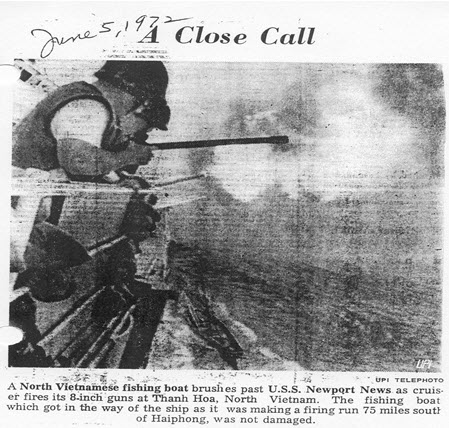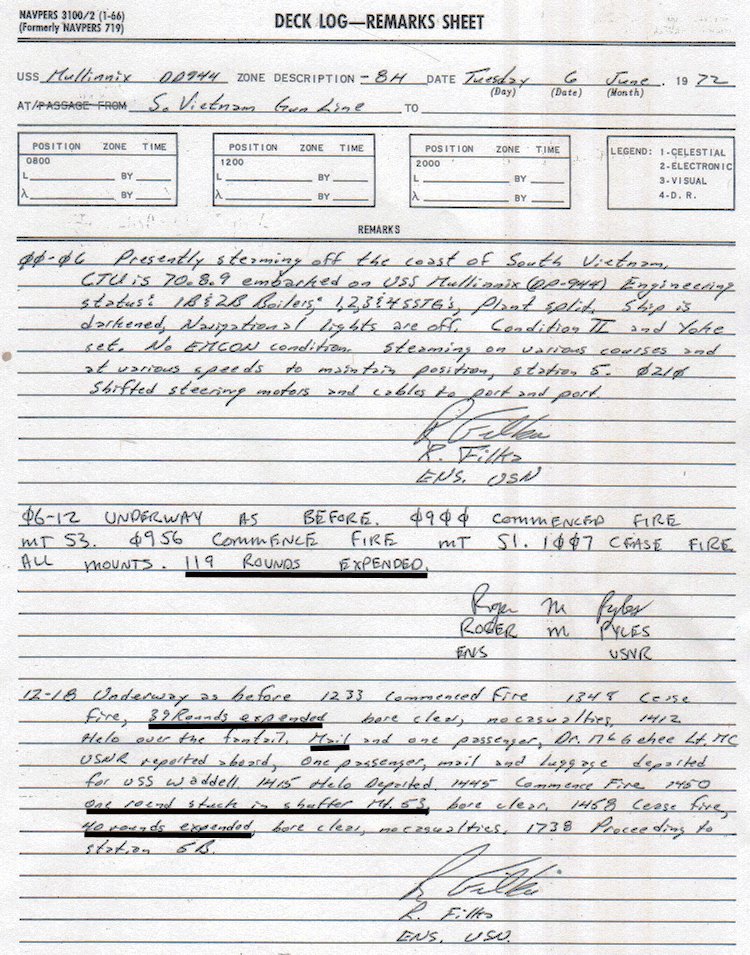 The Defense of Hue
The Defense of Hue 
 The Defense of Hue
The Defense of Hue 






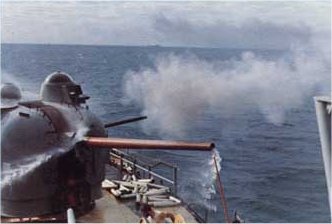  | Stars & StripesDecisive Square-Off Seen Near For HueMay 19, 1972By Edward K. Delong |
| Washington (UPI) - U.S. defense officials believe that four North Vietnamese Army divisions may now be in position to attack the old imperial city of Hue any day. They say it "could be the decisive battle of the campaign."
Officials in Washington believe a decisive South Vietnamese victory could break the back of the entire three-prong invasion launched Easter weekend by North Vietnam. A Communist victory, they say, would be a serious military and psychological blow to the South. "As to how it will come out, no none knows," one highly placed official said. "I'm optimistic (the South Vietnamese can win), but it could be very bloody, very brutal. I think it will last for days, perhaps weeks, but there will be lulls in there. "It could be the decisive battle of this campaign -for either side." Officials also said the ferocity of the North Vietnamese push and the willingness of the Communists to take "terrible" losses came as surprises. They said "we must never underestimate the resolve our enemy shows -he really has determination." Hue lies 55 miles south of the Demilitarized Zone (DMZ) that separates the two Vietnams. The troops and tanks that now threaten it punched across the DMZ, shattered South Vietnam's northern defense line and then -on May 3 -captured the provincial capital of Quang Tri about mid-way between Hue and the DMZ. The other two prongs of the offensive are aimed at a pair of other provincial capitals -Kontum City in the central highlands and An Loc about 60 miles north of Saigon. Since the fall of Quang Tri, major action on all three fronts has died into an uneasy lull punctuated by shellings and short attacks by both sides while the opposing armies regroup into position for the next round, which U.S. officials believe will start at Hue. "From the last that we could put together, they were several days away from being in a position to start the attack," one official said. "But that information could have been several days old when we got it. "My guess is we are in the period now when they could launch their attack any day," he added. "Some people are using the "by-guess-and-by-God" method and saying the 19th (Friday) is Ho Chi Minh's birthday and that's when they will attack. But there's no intelligence to support that." There is no way for the Communists to replace now much of what they lost in the first round of the invasion fighting, particularly tanks and organized army units, U.S. officials say. Hanoi stripped North Vietnam of all but one division of regular army troops, about 15,000 men, to mount the attack. South Vietnamese troops and U.S. planes and naval artillery destroyed at least 250 tanks and other heavy tracked vehicles, intelligence officials say. This was half the number on hand to launch the invasion, and one-third of North Vietnam's total inventory. The Communists also suffered an estimated more than 25,000 killed -the equivalent of almost two divisions. Many of these were regimental headquarters troops and officers, captured prisoners have reported. The northernmost Communist divisions, reinforced by some fresh troops sent down over the DMZ, are poised to the north and the southwest of Hue. Defending the city are the remainder of the South Vietnamese 3rd Division, the crack 1st Division, and elements of South Vietnamese marine and airborne troops. The official said that if the North Vietnamese overrun the defenders of Hue, mauling them badly, "then they will have delivered a very serious blow to South Vietnamese combat capability -and a serious psychological blow, too, because of the symbolic importance of Hue." "On the other hand, should they launch this attack and be thrown back with heavy casualties, it could be the last major attack on Hue for some time -for months at least," he added. |














  | Stars & StripesBloody Fighting In S. VietTuesday, May 30, 1972 |
| Saigon (AP) – Fighting blazed across the northern and southeastern sectors of Kontum City Sunday. U.S. warplanes retaliated with new air blows deep inside North Vietnam, and pilots reported wrecking the big Son Tay Army Barracks near the former American prisoner of war camp.
U.S. bombers ranged to the west and north of Hanoi to hit major targets. The Son Tay Barracks are 20 miles west of Hanoi. A second military compound was attacked 25 miles northeast of Hanoi. U.S. Air Force pilots who attacked the Son Tay Barracks and an adjoining supply depot Saturday said they left the area in flames and "large fires, heavy smoke, and major damage to the facility." The raids were among 240 strikes carried out across North Vietnam Saturday, but not disclosed by the U.S. command until Sunday. It was at Son Tay that U.S. commandos, lifted in by helicopter, made a daring raid on Nov. 22, 1970, in an effort to free American prisoners of war. They found that the American captives, shot down during missions over the north, had been moved to another camp. In another major air strike over the north, Navy pilots flying off the carrier Coral Sea attacked the Phu Lang Military Compound 25 miles northeast of Hanoi. Pilots reported they destroyed or damaged 35 to 50 railroad box and gondola cars, triggered six big secondary explosions and one large fuel fire and cut two sets of rails. Coral Sea pilots also said they dropped the northern span and damaged the southern end of the Thi Long Railroad Bridge, 18 miles south of Thanh Hoa, or about 100 miles south of Hanoi. The U.S. command said a Navy A4 Skyhawk was downed from unknown causes during Saturday's raids, about 10 miles south of Vinh. The pilot was listed as missing. Inside Kontum, heavy fighting was continuing for the fourth successive day in the southeastern sector of the city between a battalion-sized North Vietnamese force of up to 300 troops and South Vietnamese defenders. At the same time, the North Vietnamese clung to three strategically-placed positions on the northern rim of the city. Reports said that the outer northern defenses of the city had been pulled back up to a mile in a consolidation of government forces. But American and South Vietnamese military sources claimed, however, that the North Vietnamese had failed in an apparent attempt to split Kontum in half by having the northern column link with the force that is entrenched south of the city's airstrip. Before dawn Sunday, North Vietnamese forces advanced through the compound of a South Vietnamese armored cavalry unit on the northern edge of the city and drove south to within 500 yards of the airstrip, which lies in the center of the town on the eastern side. The other two strategic positions held by the North Vietnamese on the northern rim of the city are on Highway 14 and in the old 22nd Div. headquarters. South Vietnamese A37 attack planes bombed a flat, open strip of land north of the western end of the runway. This indicated that Communist forces were still in the area, despite claims by South Vietnamese and American sources that they had been cleared out. South Vietnamese bombers and rocket-firing U.S. helicopters raked Communist positions in the residential area south of the airstrip, around Highway 14 and on the eastern edges of the town. North Vietnamese gunners continued to rain shells into the city. Some fell two or three blocks from the center of town. The city was being resupplied with ammunition and other materials by air drops made by four-engine U.S. C130 transports and CH47 Chinook helicopters. The airfield remained closed. Meanwhile, delayed field reports disclosed that South Vietnamese forces suffered a major defeat last Friday on the southern front at An Loc, 60 miles north of Saigon. North Vietnamese troops firing from ambush and using mines destroyed 23 of 47 South Vietnamese armored personnel carriers trying to evacuate wounded soldiers from bloody fighting along Highway 13 south of An Loc. The field reports said 42 South Vietnamese soldiers were killed and 159 wounded in the ambush. The Saigon command said Sunday that a relief column trying to break through to the besieged provincial capital of An Loc and Clear Highway 13 had made no significant progress. Viet Cong troops, meanwhile, maintained heavy pressure in the resort province of Phuoc Tuy, 45 miles southeast of Saigon. Two district capitals were heavily assaulted, and one of them was hit with 500 mortar shells. |
  | Lincoln Journal StarShelling Belies Thieu Word on SiegeTuesday, May 30, 1972 |
| Saigon (UPI) – South Vietnamese President Nguyen Van Thieu flew Tuesday to the embattle cities of Kontum and Hue to show his confidence in the South Vietnamese defenders. He declared the siege of Kontum broken, but the thunder of artillery crashing down nearby belied his words.
The Thieu visit came as the U.S. Command reported U.S. Navy strikes against a railway yard at Haiphong had left it engulfed in flames. The Uong Bi railyards, 10 miles north of Haiphong, handle most of the rail traffic from China into the Hanoi area. Rear Adm. Hoard E. Greer, commander of Carrier Division 3 of the U.S. 7th Fleet, told UPI correspondent Arthur Higbee Tuesday that continuation of the air offensive would make it impossible for North Vietnam to keep up its offensive in the south. He said the North Vietnamese probably had enough supplies in the pipeline to continue for a few weeks. The raids on the Uong Bi complex were the first since President Nixon ordered the resumption of air strikes against North Vietnam April 6. They came as the command also reported damaging or destroying 16 more key bridges in North Vietnam and as 7th Fleet ships pounded a 260-mile stretch of coastal areas from the demilitarized zone (DMZ) to just south of Haiphong. Most supplies to the south go through a coastal highway network here. Thieu, dapper in a safari suit and blue peaked cap, flew into Kontum aboard an American-supplied T39 sabreliner executive jet. He ordered the city held at all costs, pinned a general’s star on Col. Ly Tong Ba, commander of the 23rd Infantry Division at Kontum, and credited him with ‘breaking the Communist attack’ on the city. His confidence appeared premature. North Vietnamese shells landed inside the city half a mile from 23rd Division headquarters and there was fighting with Communist snipers at three points inside the city. Spokesman said South Vietnamese forces killed 176 of the snipers Monday in fights north and south of Kontum’s airfield and inside part of a military camp they overran Sunday. ARVN losses were put at 20 dead and 108 wounded. Before Thieu visited Kontum U.S. B52s, attacking in 19 waves, dumped 1,500 tons of high explosives on Communist troops ringing the city, the second such raid in two days and raids equaling the record strikes flown around besieged Khe Sanh in early 1968. Elsewhere in Vietnam: Heavy fighting was reported between Kontum and Pleiku, 25 miles to the south with the Communists once again closing Highway 14 linking the two cities. North Vietnamese launched another extremely heavy shelling attack on a South Vietnamese convoy trying to break through to An Loc, 60 miles north of Saigon. Allied military sources said the increased tempo of the attacks clearly showed the Communists could not be withdrawing from the An Loc area. B52s hit the Mekong Delta, birthplace of the Viet Cong, for the first time in four years and struck targets around Hue as well as Kontum. |







  | Lincoln Journal StarSeaman Frank A. WoodActual Date Unknown |
| Seaman Frank A. Wood, son of Mr. And Mrs. William A. Wood, 3128 Alden, is off the South Vietnamese coast aboard the USS Mullinnix, a destroyer homeported at Norfolk, VA. |


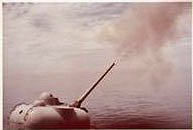


  | Saigon (UPI)So. Viets Drive to Blunt Hue DangerThursday, June 1, 1972 |
| Saigon (UPI) – South Vietnamese paratroopers and rangers backed by tanks drove almost to the border of Quang Tri Province Thursday in an effort to knock out a North Vietnamese regiment and blunted an expected attack on Hue. They moved with virtually no air support and came under heavy artillery fire.
Bad weather settled on North Vietnam and the northeastern quarter of South Vietnam but the U.S. command said its planes knocked out two more of Hanoi’s power plants Wednesday with 50 130mm artillery shells and that U.S. Air Force Phantom jets shot down two of four attaching MIG 21 jets over a 30-minute period near Hanoi. The Hanoi official army newspaper Quan Doi Nhan Dan admitted in an issue reaching Saigon that the U.S. air offensive was hurting North Vietnam’s war effort. It said the fight to maintain communications and supplies to the south was becoming more strenuous. Field officers along the My Chanh River defense line 22 miles north of Hue said the northward striking South Vietnamese armored force of 2,000 men was hit by a barrage of week – and that there were ‘quite a few’ casualties. UPI correspondent Donald Davis reported from Hue that the 3 battalions of government troops reinforced by armor were seeking to capture or destroy a battalion of 650 North Vietnamese troops in the hills just southwest of My Chanh, or drive it back north. The U.S. command said Thursday 10 Americans were killed and 35 wounded in the Indochina war last week. Eleven others were listed as missing in action and 10 dead from non-hostile causes. The casualties compared with 8 killed and 22 wounded the previous week. The Saigon command said 5,218 Communist troops were killed on Vietnam battlefields last week. The spokesmen reported South Vietnamese losses last week of 750 men killed and 2,781 wounded. The situation on other fronts: - Heavy house-to-house fighting was reported in Kontum and government spokesmen said 234 Communists were killed Tuesday and government troops found the bodies of 125 others – a total of 359 at a loss of 13 government troops killed. They said the Communists faked a surrender move Wednesday and poured reinforcements into the northern part of Kontum during a lull in the fighting. - Fighting at An Loc tapered off but the city was hit Wednesday by 50 mortar and rocket rounds and fighting was reported along three Saigon relief columns strung out from 2 to 15 miles to the south. - Fighting flared up in normally calm Bin Than Province along the South China Sea coast about 100 miles southeast of Saigon. A Communist battalion of 400 men attacked a government force 20 miles north of the provincial capital of Han Theta and was beaten back. - Southwest of Hue South Vietnamese troops said they killed 38 Communists in a skirmish 7 miles from Hue. B52s struck heavily in that area as well as in the Kontum region. |


  | Saigon (UPI)Guided U.S. Bombs Smash Big No. Viet Power PlantFriday, June 2, 1972 |
| Saigon (UPI) – U.S. warplanes smashed North Vietnam’s second biggest power plant with electronically guided bombs and bombed a major railroad bridge on the line to China military spokesmen said Friday.
Navy pilots in 220 raids Thursday also destroyed two 450-foot supply ships about a mile off the North Vietnamese coast. Many of the raids were night strikes, the U.S. Command said. Intelligence sources said Communist troops were being re-supplied for a possible major drive in the far northern quarter. Only scattered contacts were reported Friday along the northern defense line 20 miles above the old imperial capital of Hue, 400 miles north of Saigon, but heavy fighting continued in and around the central highlands province capital of Kontum, 260 miles north of Saigon. An U.S. Army UH1 helicopter was shot down Friday south of Kontum, killing one American and wounding four others aboard spokesmen said. The spokesmen also said an Air Force F4 Phantom jet fighterbomber that crashed Thursday in Thailand and been hit by a surface-to-air (SAM) missile over North Vietnam. The two-man crew parachuted and was rescued uninjured. Striking with 2,000-pound ‘smart’ bombs, Phantom crews heavily damaged the thermal power plant at Bac Giang, 25 miles northeast of Hanoi. The U.S. Command described the plant as ‘a major source of electrical power to war-related industries in the area’. Other Thailand-based Phantoms wiped out the two center spans of the five-span Cap Nung railroad bridge 52 miles northeast of Hanoi and 30 miles from the China border, spokesmen said. The bridge is a major link in Hanoi’s rail system. |



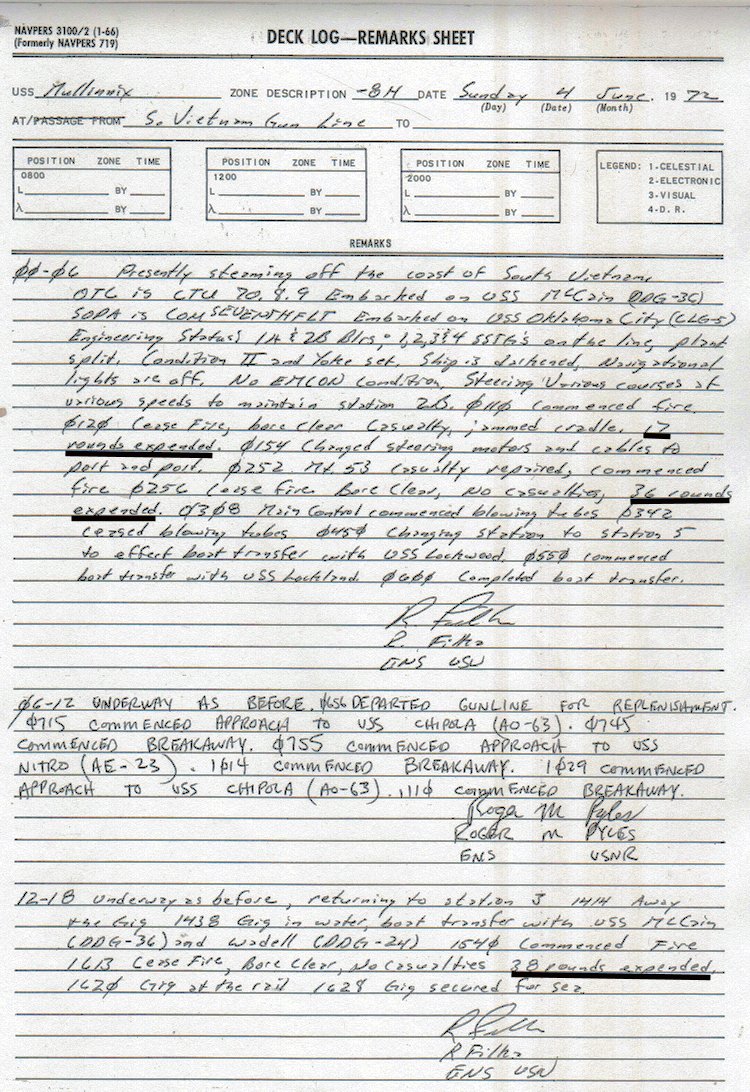

  | Compiled from News WiresHeavy Rains Bring Low-Level Air Activity to a StandstillSunday, June 4, 1972 |
| Saigon – Heavy monsoon drenched much of South Vietnam Saturday, miring the North and South Vietnamese troops in mud.
Rain hampered rapid movement and tactical air strikes especially in the vicinity of An Loc 60 miles north of Saigon and in the Central Highlands, where the city of Kontum remains under siege. Bad weather also slowed activity in the north, where South Vietnamese troops began on operation Thursday intended to seal a gap in defenses about 25 miles northwest of Hue, where enemy infiltration had been expected. There have been indications in the past few days that North Vietnamese trucks, troops and tanks may be preparing an offensive somewhere between the town of Mychanh and the mountains to the west, where the defense line protecting Hue is especially thin. Although foul weather and heavy overcast have no effect on raids by B-52 bombers, low visibility reduces helicopter and tactical air support. Worst of all, aerial surveillance of suspected infiltration routes is blocked, and it is assumed the enemy is making optimum use of cloud cover to move troops and supplies. An Air Force crewman who had been missing for 23 days after his plane was downed north of Hanoi has been rescued by a team of American helicopters and planes, it was learned today. The missing man, Capt. Roger C. Locher of Sabetha, Kan., reportedly had lost 15 pounds when he was rescued and returned to the American base at Udora, Thailand. Locher, a weapons system operator, had been flying in the rear seat of an F-4 Phantom jet when it was shot down by a MIG 21 on May 10. Thailand-based American Phantom pilots downed a North Vietnamese MIG 19 fighter that challenged U.S. bombers 40 miles north of Hanoi on Friday, military spokesmen said Saturday. It was the 146th MIG shot down by U.S. aircraft since President Johnson ordered the bombing of the North in 1964 and the 35th downed this year. It was hit by a Phantom piloted by Maj. Phillip Handley, 37 of Arlington, TX. |
  | Saigon (AP)250 U.S. Strikes Reported on RedsSunday, June 4, 1972 |
| Saigon (AP) – American planes struck more than 250 times in North Vietnam and gunned down their 35th MIG interceptor this year, the U.S. Command reported Saturday.
As the air attacks continued, North Vietnamese troops increased pressure on Binh Dinh, South Vietnam’s central coast province with more than a million inhabitants and a vital rice crop. Four artillery rounds landed on a South Vietnamese ammunition dump at Phu My, a district capital, sparking thunderous explosions for 3 ½ hours. Two U.S. advisers had already evacuated Phu My, 32 miles north of the Binh Dinh capital, Qui Nhon. Field reports noted fighting there and also 80 miles south in Quang Ngai Province. Officials said scores of U.S. Air Force, Navy, and Marine aircraft blasted targets in an area in North Vietnam stretching from Hanoi south to the key port of Vinh, destroying 9 bridges, 43 supply buildings, 21 storage areas, 41 trucks and 36 boats. In South Vietnam, defenders at the Central Highlands provincial capital of Kontum reported the quietest day since North Vietnamese troops seized parts of the town 10 days ago. 7 enemy soldiers were killed. There were no South Vietnamese casualties despite sporadic attempts to clears some areas remaining under enemy control, spokesmen said. There was shelling and some fighting along Highway 14 to Pleiku and North Vietnamese units mined and temporarily blocked Highway 19 linking Pleiku to Qui Nhon on the coast, field reports said. |


